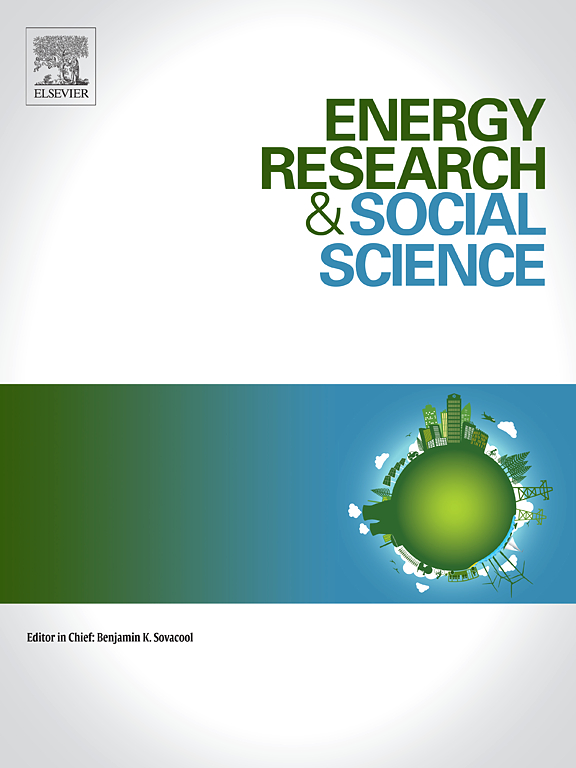住房和家庭对夏季过热的脆弱性:英国的潜在分类
IF 6.9
2区 经济学
Q1 ENVIRONMENTAL STUDIES
引用次数: 0
摘要
日益加剧的全球变暖和气候变化对最小化建筑物过热和对机械冷却的需求提出了挑战,特别是对最脆弱的人群。全面了解影响过热的因素有助于在气候变暖的情况下设计更健康、更安全的住房。众所周知,不同的社会和材料特性会影响室内过热的脆弱性。然而,迄今为止,缺乏通过关注他们对过热的主观体验如何变化来集中理解社会脆弱性的研究。作为回应,本研究调查了主观过热脆弱性,分析了最近最大的英国住宅样本,包括11,152户家庭。在方法上,使用潜在类别分析,衍生出四个类别,突出特定的住房特征,增加家庭经历过热的可能性。我们强调了特定建筑特征(如公寓,绝缘实心墙)和租赁安排(如社会和私人租赁)在加剧过热风险方面的关键作用,特别是当弱势群体居住在其中时。特别是低收入家庭、老年人或退休成员以及年轻人更有可能报告经济过热的风险。通过揭示主观过热的住房和家庭特征之间的关系,我们强调了室内过热问题的多面性,并为国内决策者考虑低碳建筑方案和热舒适法规提供了启示。本文章由计算机程序翻译,如有差异,请以英文原文为准。
Housing and household vulnerabilities to summer overheating: A Latent Classification for England
Increasing global warming and climate change pose a challenge for minimising overheating in buildings and the demand for mechanical cooling, particularly for the most vulnerable populations. A thorough understanding of the factors that influence overheating can facilitate the design of healthier and safer housing under a warming climate. Diverse social and material characteristics are known to shape vulnerability to indoor overheating. However, to date, there is a lack of research that centres understanding of social vulnerabilities by focusing on how their subjective experiences of overheating vary. In response, this research investigates subjective overheating vulnerabilities analysing the largest recent sample of English dwellings, comprising 11,152 households. Methodologically, using Latent Class Analysis, four classes are derived which highlight specific housing characteristics that increase the likelihood of a household experiencing overheating. We highlight the crucial role of specific building characteristics (e.g. flats, insulated solid walls) and tenancy arrangements (e.g. social and private renting) in exacerbating overheating risks, especially when vulnerable groups reside in them. Particularly, households with low incomes, older or retired members and younger individuals are more likely to report the risk of overheating. By revealing relationships between housing and household characteristics regarding subjective overheating, we highlight the multifaceted nature of the indoor overheating issue with implications for domestic policymakers considering low-carbon building schemes and regulations on thermal comfort.
求助全文
通过发布文献求助,成功后即可免费获取论文全文。
去求助
来源期刊

Energy Research & Social Science
ENVIRONMENTAL STUDIES-
CiteScore
14.00
自引率
16.40%
发文量
441
审稿时长
55 days
期刊介绍:
Energy Research & Social Science (ERSS) is a peer-reviewed international journal that publishes original research and review articles examining the relationship between energy systems and society. ERSS covers a range of topics revolving around the intersection of energy technologies, fuels, and resources on one side and social processes and influences - including communities of energy users, people affected by energy production, social institutions, customs, traditions, behaviors, and policies - on the other. Put another way, ERSS investigates the social system surrounding energy technology and hardware. ERSS is relevant for energy practitioners, researchers interested in the social aspects of energy production or use, and policymakers.
Energy Research & Social Science (ERSS) provides an interdisciplinary forum to discuss how social and technical issues related to energy production and consumption interact. Energy production, distribution, and consumption all have both technical and human components, and the latter involves the human causes and consequences of energy-related activities and processes as well as social structures that shape how people interact with energy systems. Energy analysis, therefore, needs to look beyond the dimensions of technology and economics to include these social and human elements.
 求助内容:
求助内容: 应助结果提醒方式:
应助结果提醒方式:


